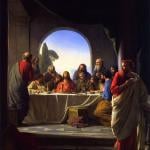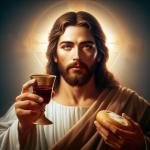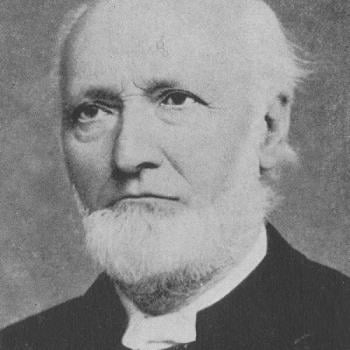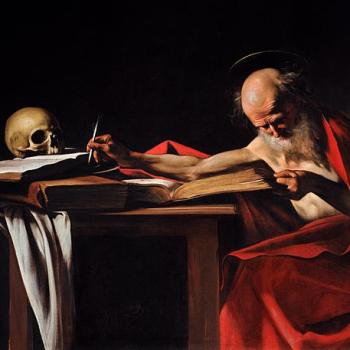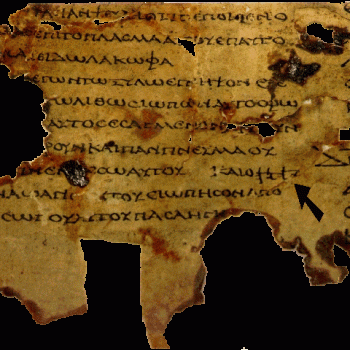Does Turretin think biblically in this regard or hyper-rationally and skeptically?
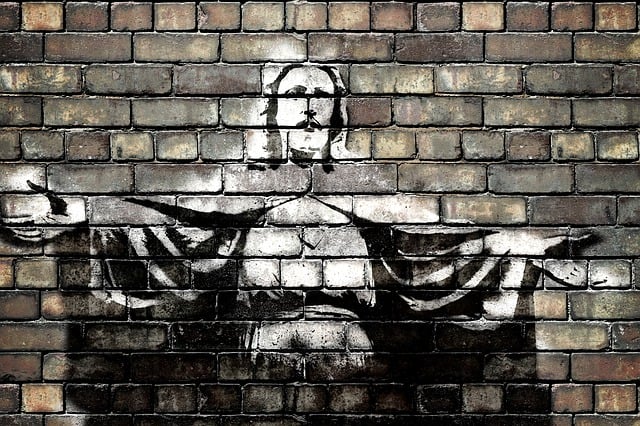
François Turretin (1623-1687) was a Genevan-Italian Reformed scholastic theologian and renowned defender of the Calvinistic (Reformed) orthodoxy represented by the Synod of Dort, and was one of the authors of the Helvetic Consensus (1675). He is generally considered to be the best Calvinist apologist besides John Calvin himself. His Institutes of Elenctic Theology (three volumes, Geneva, 1679–1685) used the scholastic method. “Elenctic” means “refuting an argument by proving the falsehood of its conclusion.” Turretin contended against the conflicting Christian perspectives of Catholicism and Arminianism. It was a popular textbook; notably at Princeton Theological Seminary, until it was replaced by Charles Hodge‘s Systematic Theology in the late 19th century. Turretin also greatly influenced the Puritans.
This is a reply to portions of a section of Institutes of Elenctic Theology (Vol. 3, 19th Topic: The Sacraments / 27th Question: Transubstantiation). I utilize the edition translated by George Musgrave Giger and edited by James T. Dennison, Jr. (Presbyterian and Reformed Publishing Company, Phillipsburg, New Jersey: 1992 / 1994 / 1997; 2320 pages). It uses the KJV for Bible verses. I will use RSV unless otherwise indicated. All installments of this series of replies can be found on my Calvinism & General Protestantism web page, under the category, “Replies to Francois Turretin (1632-1687).” Turretin’s words will be in blue.
*****
In the Eucharist, is there an entire conversion of the substance of the bread and wine into the body and blood of Christ; or are the bread and wine, in virtue of the words of consecration, truly transubstantiated into the very body and blood of Christ, the external species only of the bread and wine remaining? We deny against the Romanists[.]
Although from the discussion of the preceding question, the decision of this can easily be made (for if it is once certain and indubitable that the sacramental words are figurative and tropical, as has been proved, the dogma of transubstantiation falls by that very thing, being founded solely upon the literalness of the words . . .
It’s anything but “certain and indubitable that the sacramental words are figurative” as I submit that I demonstrated in my previous reply. Turretin is now proceeding by assuming a false and undemonstrated premise.
yet because our opponents are desperately in love with this figment (as their Helen) and fiercely contend for it (as if for their altars and firesides), the treatment of this controversy must not be omitted.
We’re “desperately in love with” whatever Holy Scripture and Holy Tradition teach us. As the Bible itself states: “The sum of thy word is truth” (Ps 119:160).
the question does not simply concern the presence of Christ in the Supper; for this belongs to another controversy which will be taken up after this. Rather the question concerns the presence of Christ effected by way of conversion. . . . the question concerns a change as to substance—whether a real conversion is made of the substance of the bread and wine into the substance of the body and blood of Christ. . . . We deny it and maintain that the bread and wine, although they are changed as to use according to the institution of God, yet they always retain their own substance, and that no real change or conversion takes place in reference to them.
This is a good description of the competing positions.
First, as to the senses. What many senses properly disposed and furnished with all the requisites for action, uniformly always and everywhere testify—that is necessarily true. Now the senses with one accord (homothymadon) testify that after the consecration, the symbols are properly bread and wine, not body and blood. Therefore, this is necessarily true.
I already refuted this thinking last time, citing an article of mine from 2000:
The virgin birth, . . . cannot be observed or proven, and is the utter opposite of a demonstrable miracle, yet it is indeed a miracle of the most extraordinary sort. Likewise, in the atonement of Jesus the world sees a wretch of a beaten and tortured man being put to death on a cross. The Christian, on the other hand, sees there the great miracle of redemption and the means of the salvation of mankind – an unspeakably sublime miracle, yet who but those with the eyes of faith can see or believe it?
Many miracles in Christianity are of such a nature that they cannot be perceived by the senses alone. In other words, not all knowledge is empirical (of the senses). The incarnation itself — as another example — can in no way be established through the senses (by simply looking at Jesus if one had been alive during His time). How can one determine whether God is eternal through the senses? We can’t even comprehend eternity into the future, let alone infinitely extended back in time and before (or outside of) time itself. Yet all Christians including Turretin believe in that doctrine. Or we could talk about the Holy Trinity or many other doctrines.
Otherwise we would have to say that there is nothing certain in the nature of things and the testimony of all the senses would have to be condemned with the academicians (which the thing itself proclaims to be most absurd).
We need to do no such thing. There is nothing “anti-scientific” entailed in believing in transubstantiation. All we need to do is what I just did: note the obvious fact that not all knowledge is obtained through the senses. The Bible clearly teaches this: “faith is the assurance of things hoped for, the conviction of things not seen” (Heb 11:1). Even after appearing to Doubting Thomas and mercifully providing Him with empirical proof of His resurrection, Jesus went on to proclaim that “Blessed are those who have not seen and yet believe” (Jn 20:29).
In vain is it objected: (1) “The senses cannot give a judgment concerning mysteries, which are the object of faith, far surpassing the senses.”
Yes, I essentially did just assert that. Let’s see how Turretin deals with it.
For although it is certain that the senses cannot judge of spiritual things as such (which occur in the mysteries of faith and transcend the senses), it does not follow that they cannot be consulted about sensible, visible things (which can occur in the mysteries). Undoubtedly two classes of mysteries are especially to be distinguished here. The one, wholly removed from corporeal things and as to all their parts mysteries, concealing themselves from us and far transcending the sphere both of reason and of the senses. These we hold are the object of faith alone, not of reason or of the senses. They are to be judged by the revelation of the word alone, not by the decision of reason or the testimony of the senses. However, the other involved and connected with corporeal and sensible things (as the mystery of the incarnation, of the resurrection of Christ, and the various miracles brought by him), which have sensible things annexed to spiritual. Concerning the truth and certainty of these, the senses and reason can give their testimony. We maintain that the sacraments are such mysteries in which, accordingly, the senses of which they are the proper object are not to be excluded, but listened to.
I’m glad he brought up the incarnation. What sense can prove that Jesus was the incarnate God merely by looking at Him or touching Him? The incarnation has everything to do with matter, since God became man. But it’s not verified by eyesight or touch. Jesus looked, felt, and sounded like a man; no one but those possessing faith would know (from simply observing Him) that He was also God, an uncreated Person who had made everything upon which He stood. No blood test or any sort of scientific test could reveal that. The virgin birth is in the same category as well. It was a thing involving matter but it can’t be verified in an empirical sense. Even today, if we could hypothetically use science to observe how Jesus the man came into the world (through microscopic observation), we couldn’t determine by that method alone that this male child was God.
In my previous installment I noted how God appeared in the pillars of cloud and fire in the Old Testament. Clouds consist primarily of carbon dioxide, water vapor, oxygen and nitrogen. Yet God was somehow “in” them. How? How could one tell the difference between a regular old cloud or a fire and the ones that God was “in”? They couldn’t (by scientific/empirical criteria). And no one could today, either, if God did that again. The only difference is that God said he was in both, in particular circumstances when both formed a “pillar.” But that’s not physical proof. It’s revelation. And it is exactly the same, analogously, as what we have in the Eucharist (substance changing without the accidents or appearances changing).
God made a donkey talk to Balaam (Numbers 22:21-31: “the LORD opened the mouth of the ass”: 22:28). Now, how would one go about demonstrating a physical change in the donkey, which now enabled it to speak (whereas we normally assume that animals do not speak, and not in the language we understand)? Would a neurologist be able to examine the brain of the animal and figure out how it could speak; what change was in the brain compared to those of non-speaking donkeys? I doubt it. But Bible-believing Christians think this actually happened and that we can’t hyper-analyze and explain it through the usual scientific means of verification.
Here again there was no outward change (the “accidents” perceived by our senses remained the same), but a miracle occurred in which a donkey talked. In other words, it is analogous to the Eucharist.
It is no more rightly said, “The senses cannot judge in this matter because the reference is to an internal change in the substance of the bread, which does not strike the senses, because they stop with the external accidents.” This rests upon a false hypothesis—that the accidents are really distinguished from the substance and can be separated from it and subsist separately.
The latter state of affairs is true of the incarnation. Senses tell us that Jesus was an ordinary man. How can senses prove that He was God and man? They can’t, because that is determined and believed in spiritually and philosophically. No microscope can identify anything in Jesus’ body that would prove that He was also God come down to earth. Therefore, the accidents of Jesus’ body have characteristics distinct and separate from the reality that He was God in the flesh. The accidents show nothing whatsoever of His divinity.
Just as we couldn’t tell that Jesus was vastly, essentially different from an ordinary human being by senses alone, likewise, we can’t tell that what was bread and wine before the consecration have become the body and blood of Jesus after it. It’s not discerned by the senses but received by faith and revelation. Jesus’ body didn’t “look like God” just as the consecrated elements don’t look like God, but we believe that they are by an informed faith that isn’t opposed to science, but rather transcends its sphere of knowledge. Science can’t speak to it.
On the contrary, while it is certain that they are inseparable from the substance (nay, are really identified with it), whoever sees the accidents of a substance, by that very thing sees the substance itself, which can be seen in no other way than by its accidents.
Again, this is clearly not true concerning the incarnation, as just explained. By the same token, the consecrated elements that don’t look like God, either, judging by the evidence of our senses. Turretin argues like a pagan rationalist. He’s simply not thinking and analyzing deeply enough. His reasoning fails since it would “prove” that the incarnation is a falsehood. Therefore, by reductio ad absurdum, it also fails by analogy in the case of the Eucharist.
Second, reason must be heard here, with which transubstantiation conflicts in many ways. Sound reason teaches that only one body occupies one place and cannot be at the same time in more places than one because it would be one and not one, standing apart from itself and exposed to various and contrary motions, which everyone sees to be absurd (asystaton).
Reason doesn’t disprove the supernatural and the miraculous. Again, he reasons like a pagan hyper-rationalist, as opposed to a Christian who believes any number of amazing things that go beyond the natural and the laws of science. Both reason and experience tell us that a physical body can’t go through walls, either. But Jesus did that, in His resurrected body (Jn 20:19, 26). In the same context, Jesus showed that He had a physical body: “Put your finger here, and see my hands; and put out your hand, and place it in my side” (Jn 20:27). He did the same thing in another post-resurrection appearance, to the two disciples walking to Emmaus:
Luke 24:36-43 As they were saying this, Jesus himself stood among them. [37] But they were startled and frightened, and supposed that they saw a spirit. [38] And he said to them, “Why are you troubled, and why do questionings rise in your hearts? [39] See my hands and my feet, that it is I myself; handle me, and see; for a spirit has not flesh and bones as you see that I have.” [41] And while they still disbelieved for joy, and wondered, he said to them, “Have you anything here to eat?” [42] They gave him a piece of broiled fish, [43] and he took it and ate before them.
The point I’m making is that the risen Jesus had a body, but it had characteristics that normal bodies didn’t have: the ability to somehow “dematerialize” and go through walls (sort of like being “beamed up” in the TV show Star Trek). No one could have perceived that this was possible by putting their hand in the risen Jesus’ side or the wounds in His hands and feet. In other words, it’s another miracle regarding physical matter that can’t be discerned by our senses, just as transubstantiation is. Turretin contends that bodies can’t be in two places at one time. But we retort that — speaking of a strictly physical plane — neither can bodies go through walls; nor can a person raise Himself from the dead, as Jesus did (Jn 2:19-21; 10:17-18), or raise others from the dead, as He and His disciples both did.
Both things are supernatural. If one thing is possible, the other is entirely possible as well. It can’t be ruled out by either reason or the senses. It’s both possible and actual because God is God, and is omnipotent. But Turretin — not understanding all of this or consistently incorporating it into his thinking — problematically acts like the rebellious disciples and the unbelieving Jews in John 6, after Jesus said that bread and wine could become His body and blood:
John 6:52 The Jews then disputed among themselves, saying, “How can this man give us his flesh to eat?”
John 6:60-61, 64, 66 Many of his disciples, when they heard it, said, “This is a hard saying; who can listen to it?” [61] But Jesus, knowing in himself that his disciples murmured at it, said to them, “Do you take offense at this? . . . [64] . . . there are some of you that do not believe.” For Jesus knew from the first who those were that did not believe, and who it was that would betray him. . . . [66] After this many of his disciples drew back and no longer went about with him.
A body cannot be granted which does not have quantity and extension, since quantity and extension do not differ really from the material substance, but
are identified with it.
In the purely natural world, this is true. But in the supernatural world, where bodies and other material things have extraordinary capabilities, Jesus’ body and blood in the Eucharist have characteristics that normal bodies don’t have. Miracles always entail going beyond the natural. It’s almost as if Turretin can’t or won’t make exceptions to the laws of nature, for miracles. All of a sudden he has no belief in miracles, when it comes to the Eucharist. But why should it be different from any other miracle? Donkeys can’t and don’t talk; yet one talked to Balaam; human beings have no power over whether it rains or not; yet Elijah did; etc., etc.
All these and many other monstrosities of the same kind (which we desist from enumerating) are not so much prodigies of nature, as most absurd and inconsistent (asystata) creations of the human imagination, bringing the Christian religion into disgrace with infidels. They are the monstrous consectaries of the dogma of transubstantiation, which right reason not only does not receive, but is constantly opposed to.
To the contrary, all of the aspects of the Holy Eucharist that Turretin enumerated are every bit as possible as all the other miracles that we see described in the Bible. Once the miraculous (anything outside of the laws of nature) is possible in the first place, then any and all “strange” scenarios are possible. Turretin arbitrarily sets apart the one miracle involved in transubstantiation and declares it “monstrous” and a “disgrace” but he does so only by thinking in a radically unbiblical, hyper-rationalistic, cynical and skeptical way.
The factuality or possibility of miracles or supernatural events aren’t determined on the basis of whether we personally like them or not. If we take that approach, we’re like the unbelieving Pharisees who opposed Jesus: “It is only by Be-el’zebul, the prince of demons, that this man casts out demons” (Mt 12:24). Jesus’ response to their unbelief was to say, “He who is not with me is against me, . . . every sin and blasphemy will be forgiven men, but the blasphemy against the Spirit will not be forgiven” (Mt 12:30-31). This was not merely a lack of ability to believe; but sinful unbelief, worthy of, ultimately, a sentence of hell. Turretin and those who think like him in this respect are treading very spiritually dangerous ground.
Although we do not deny that the mysteries of faith are above reason, still we do not think that they are contrary to it; so that if their truth cannot be proved from reason, still their credibility may be sufficiently established by faith.
We deny that transubstantiation is contrary to reason, and I have made arguments establishing that, and these need to be grappled with. But Protestants are exceedingly unwilling to do that, which is why I’m sitting here “debating” with a dead guy. That’s fine with me. Turretin is one of the best historic Protestant theologians. Yet we see that his arguments regarding transubstantiation are very weak, and scarcely even biblical or Christian in nature. They do, however, fit right in with the approach of the village atheist, who denies every miracle in the Bible or in life in general. But at least the atheist is consistent. He doesn’t arbitrarily choose which miracle he will reject, while accepting others, on no rational or consistent basis, other than (it seems to come down to) rejecting them simply because Catholics accept them; sort of a “guilt by association.”
Reason may be blind and corrupted, repugnant to revelation and rising up against it; or it may be sound and well constituted, consenting to it and subordinated to it. . . . grace does not destroy nature, but makes it perfect; nor does faith exclude, but supposes reason.
Very true!
Finally, some mysteries of faith are true and genuine, clearly revealed in the Scriptures; others are false and spurious, not the streams and rays of divine revelation, but the offspring of human ignorance and blindness. Although reason is not sufficient to demonstrate the latter, still she is sufficient to strip off their deceitfulness and falsity. We maintain that the figment of transubstantiation is such.
And I have provided many biblical arguments by analogy, and arguments from reason and logic, for why we believe it is a true and biblical doctrine. Let the reader choose who has the more plausible and cogent case!
What is said of natural being and of sacramental being could be admitted, if by sacramental being is meant the symbolic and significative being of the bread (inasmuch as it is the sacrament of the body of Christ), but not with regard to his natural body (concerning which we speak).
Turretin irrationally limits himself in his thinking, by assuming hyper-rationalism and disallowing (as if he has the prerogative to do so) the supernatural to extend to this subject. In “epistemological despair” he adopts symbolism and metaphor, rather than accept the truth of eucharistic realism. Again, he neglects to realize that Jesus’ “natural body” after He resurrected, was capable of going through walls, in opposition to the laws of nature. And even before that, Jesus raised Himself. How many dead bodies do we see rising up again, through their own power? He ascended to heaven by His own power as well.
I submit that those three things are just as strange and unexpected as Jesus entering into bread and wine and changing them into His body and blood. If one can accept the first three (as Turretin and Protestants do), I see no reason why they can’t accept the fourth thing: transubstantiation. So the question becomes: what determines if a miracle is “monstrous” or a “disgrace”? Turretin has not resolved that dilemma. He’s simply playing games with words and philosophical concepts and placing skeptical philosophy above faith.
For if the form (superficies) alone remains, how could Christ and Paul so often call it bread and the fruit of the vine?
In part, they speak phenomenologically, as Bible writers often do, and/or refer to the accidents or outward characteristics in those instances. But they simultaneously call what was bread and wine Jesus’ body and blood, after they are consecrated (Jesus does so repeatedly in John 6). They do both things, which is perfectly consistent with the Catholic position. I will treat this issue in more depth in my next installment.
We do not treat here of what God can do, but of what he wishes to do. The power of God is not the rule of our faith, but his will. For although all things are possible to God, he does not at once do whatever he is able, but only what he wishes.
Fair enough. The Catholic argues that God did indeed wish to do this, based on the relevant texts (the Last Supper, John 6, and Paul’s eucharistic passages). All taken together strongly support our view; so we argue. It’s a straightforward biblical perspective; whereas I contend that Turretin’s argument is hyper-rationalistic and skeptical and insufficiently biblical.
Omnipotence extends itself to all things possible, but not to those which are impossible; such as are those which imply a contradiction, which God can no more be said to be able to do than it be said that he is able to lie and sin. Nor are these marks of power, but of a defect and imperfection, which God not only cannot do, but which he cannot even will to do, because they are contrary to his wisdom, holiness and truth and repugnant to the laws established by him in nature.
There is no inherent contradiction in God changing bread and wine into His body and blood. It’s odd, strange, and not predictable, but not contradictory. God can certainly do this. He’s not limited by all of these laws of matter, that Turretin tries so hard to enlist as alleged disproofs of this miracle, simply because he doesn’t like eucharistic realism. Turretin almost seems to say that God is constrained by the very laws of nature that He created. He’s not at all, of course. Every miracle proves this. I agree with St. John Henry Cardinal Newman, a truly towering intellect, whom few would accuse of being unreasonable, gullible, or philosophically naive, who commented on this issue as follows:
People say that the doctrine of Transubstantiation is difficult to believe . . . It is difficult, impossible to imagine, I grant – but how is it difficult to believe? . . . For myself, I cannot, indeed prove it, I cannot tell how it is; but I say, ‘ Why should it not be? What’s to hinder it? What do I know of substance or matter? Just as much as the greatest philosophers, and that is nothing at all.’ (Apologia pro vita Sua, Garden City, New York: Doubleday Image, 1956; originally 1864; 318: part 7: “General Answer to Mr. Kingsley”)
Although we confess that God can work above the order of nature, still we deny that his omnipotence extends to those things which are contrary to nature and the order established in it, because he cannot change the natures of things and overturn the order settled by himself.
This is sheer nonsense. It is as I suspected: Turretin turns God into a caricature of Himself; a sort of deist “god” rather than the sovereign Master of the universe. Again, every miracle makes mincemeat of this self-contradictory gibberish.
Although God can make accidents with their subjects, it does not follow in like manner that he can also produce the former without the latter; not from a lack of power, but from the incompossiblity (incompossibilitate) of the thing.
It’s not impossible at all! Turretin deludes himself. Here are some things that are actually impossible, even for God: He can’t make Himself exist and not exist at the same time or to be simultaneously eternal and not eternal. He can’t make a circle a square. He can’t simultaneously subsist in Four Divine Persons and Three, or create a world in which 2+2=4 and also equals 5. And (here’s the famous one), He can’t make a rock so big that He can’t lift it, because that’s a logical self-contradiction.
All of those things are impossible for even an omnipotent being to do. But transubstantiation is not of the same nature as all of these things, and is entirely possible and not self-contradictory. Turretin builds his entire case upon the laws of nature, but he himself admits that “God can work above the order of nature.” Yes! And He does so in transubstantiation. He states a true principle, but then proceeds to ignore it and make an “exception” based on nothing solid or incontrovertible at all. It’s equally extraordinary and distressing to behold a brilliant Christian mind engage in such tortuous thinking and skeptical illogic.
But the mind cannot conceive an accident which is without its subject.
Sure it can. On what basis does he make this claim? We can conceive of it just as we do in the case of a cloud or fire having the usual properties that they do, while containing God within them, which the Old Testament states was the case. How could we know that God was there, except that He revealed that He was by revelation or divine utterance? To us it’s just a cloud and fire, if we only employ our senses. It’s the same with transubstantiation. God said that He is now present after the consecration, whereas to us it looks and tastes and feels like bread and wine. But we believe it isn’t based on God’s revelation, the Bible. But Turretin, oddly enough, thinks like the biblical “carnal” or “unspiritual” man, that Paul describes:
1 Corinthians 2:7, 10-14, 16 . . . we impart a secret and hidden wisdom of God, which God decreed before the ages for our glorification. . . . [10] God has revealed to us through the Spirit. For the Spirit searches everything, even the depths of God. [11] For what person knows a man’s thoughts except the spirit of the man which is in him? So also no one comprehends the thoughts of God except the Spirit of God. [12] Now we have received not the spirit of the world, but the Spirit which is from God, that we might understand the gifts bestowed on us by God. [13] And we impart this in words not taught by human wisdom but taught by the Spirit, interpreting spiritual truths to those who possess the Spirit. [14] The unspiritual man does not receive the gifts of the Spirit of God, for they are folly to him, and he is not able to understand them because they are spiritually discerned. . . . [16] “For who has known the mind of the Lord so as to instruct him?” But we have the mind of Christ.
*
***
*
Photo credit: Image by TheDigitalArtist (1-1-20) [Pixabay / Pixabay Content License]
Summary: Calvinist theologian François Turretin contended that transubstantiation is “monstrous” & impossible to believe. I offer numerous opposing biblical analogical & logical arguments.


